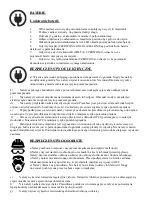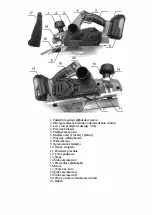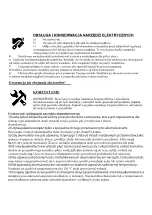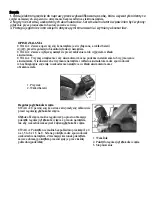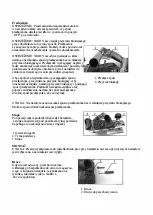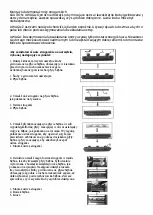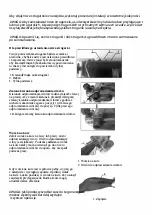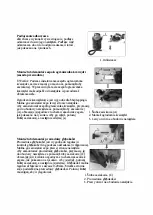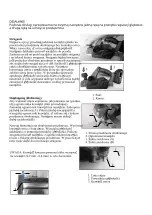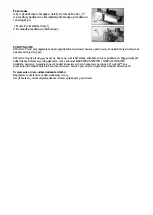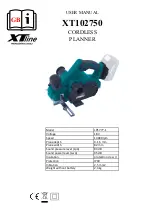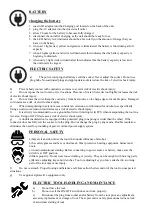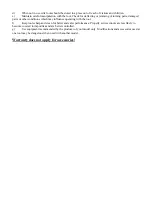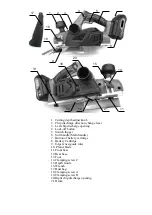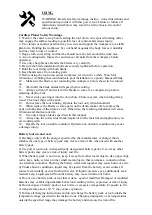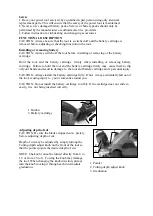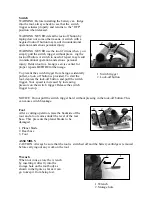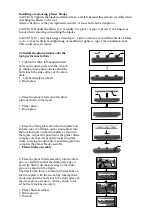
USING
WARNING: Read all safety warnings, instruc- tions, illustrations and
specifications provided with this power tool. Failure to follow all
instructions listed below may result in electric shock, fire and/or
serious injury.
Cordless Planer Safety Warnings
1. Wait for the cutter to stop before setting the tool down. An exposed rotating cutter
may engage the surface leading to possible loss of control and serious injury.
2. Use clamps or another practical way to secure and support the workpiece to a stable
plat-form. Holding the workpiece by your hand or against the body leaves it unstable
and may lead to loss of control.
3. Rags, cloth, cord, string and the like should never be left around the work area.
4. Avoid cutting nails. Inspect for and remove all nails from the workpiece before
operation.
5. Use only sharp blades. Handle the blades very carefully.
6. Be sure the blade installation bolts are securely tightened before operation.
7. Hold the tool firmly with both hands.
8. Keep hands away from rotating parts.
9. Before using the tool on an actual workpiece, let it run for a while. Watch for
vibration or wobbling that could indicate poor installation or a poorly balanced blade.
10. Make sure the blade is not contacting the workpiece before the switch is turned
on.
11. Wait until the blade attains full speed before cutting.
12. Always switch off and wait for the blades to come to a complete stop before
adjusting depth of cut.
13. Never stick your finger into the chip chute. Chute may jam when cutting damp
wood. Clean out chips with a stick.
14. Do not leave the tool running. Operate the tool only when hand-held.
15. When replace the blades or some parts on the drum, make sure to replace the
parts on both sides of the drum as a set. Otherwise, the resulting imbalance will cause
vibration and shorten tool life.
16. Use only Liangye blades specified in this manual.
17. Always use the correct dust mask/respirator for the material and application you
are working with.
18. Operate the tool on stable condition. Operation on unstable condition may cause
a damage injury.
Battery tool use and care
1)
Recharge only with the charger specified by the manufacturer. A charger that is
suitable for one type of battery pack may create a risk of fire when used with another
battery pack.
2)
Use power tools only with specifically desig-nated battery packs. Use of any other
battery packs may create a risk of injury and fire.
3)
When battery pack is not in use, keep it away from other metal objects, like paper clips,
coins, keys, nails, screws or other small metal objects, that can make a connection from
one terminal to another. Shorting the battery termi-nals together may cause burns or a fire.
4)
Under abusive conditions, liquid may be ejected from the battery; avoid contact. If
contact acci-dentally occurs, flush with water. If liquid con-tacts eyes, additionally seek
medical help. Liquid ejected from the battery may cause irritation or burns.
5)
Do not use a battery pack or tool that is dam- aged or modified. Damaged or modified
batteries may exhibit unpredictable behaviour resulting in fire, explosion or risk of injury.
6)
Do not expose a battery pack or tool to fire or excessive temperature. Exposure to fire
or tem-perature above 130 °C may cause explosion.
7)
Follow all charging instructions and do not charge the battery pack or tool outside the
temperature range specified in the instruc-tions. Charging improperly or at temperatures
outside the specified range may damage the battery and increase the risk of fire.

